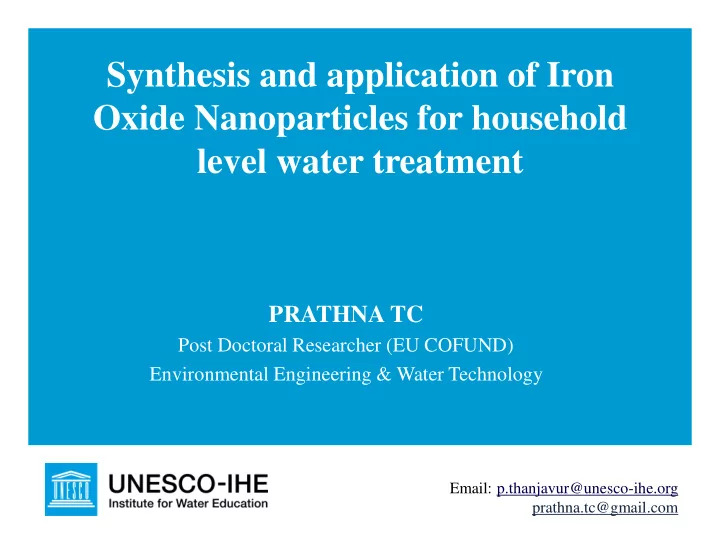

Synthesis and application of Iron Oxide Nanoparticles for household level water treatment PRATHNA TC Post Doctoral Researcher (EU COFUND) Environmental Engineering & Water Technology Email: p.thanjavur@unesco-ihe.org prathna.tc@gmail.com
OUTLINE • Background • Aim and objectives • Methodology • Results • Conclusion & Future Scope
BACKGROUND Approximately 663 million people around the world lack access to safe drinking water Targets of United Nations SDG- ensure safe and affordable drinking water by 2030 WHO/UNICEF (2015). Progress on Drinking-water and Sanitation 2015 Update. Joint-Monitoring Programme: World Health Organization and United Nations Children Education Fund, 1, 1. http://www.un.org/sustainabledevelopment/water-and-sanitation/
Worldwide distribution of Arsenic & Fluoride contamination http://www.iupac.org/publications/ci/2008/3004/2_garelick.html http://www.unicef.org/wes/files/wfl3e.pdf
Co-contamination of arsenic and fluoride in drinking water WHO permissible limit in drinking water: As: 10 ppb F: 1.5 ppm Coexistence of arsenic and fluoride in aquifers has been observed in many places with concentrations exceeding 100 ppb (As) and 30 ppm (F) Widespread problem in rural areas where communities often depend on groundwater as the sole drinking water source Simultaneous removal of As and F simplifies treatment process and reduces cost WHO, Guidelines for Drinking Water Quality, Second edition, volume 1, recommendations, Geneva, WHO 1993 p57/pp114-121 J Qiao, Z Cui, Y Sun, Q Hu, X Guan, Front Environ Sci Eng, 2014, 8(2), 169
Adsorption The amount of water required is relatively less The process is less energy intensive Simple operation- no post treatment step Economic reliability Why iron oxide? Cost effective Possess magnetic properties for efficient separation Excellent sorbents for Arsenic (~95 mg/g) and Fluoride (~90 mg/g) at lower pH Z Ren, G Zhang, JP Chen, J Colloid Interface Sci, 2011, 358, 230
Why nanoparticles? Sorption occurs at the interface of solid and fluid phases, implying that a large surface area of sorbent favours both sorption rate and capacity Iron oxide nanoparticles for household level water treatment Ease of synthesis and availability Can be easily coated onto suitable support
OBJECTIVES To synthesize iron oxide nanoparticles To evaluate the efficacy of the synthesized material in removing Fluoride and Arsenic from contaminated water sources To utilize the insights from batch studies in scale up studies To design an affordable household level water purification device using the synthesized nanoparticles
METHODOLOGY CHARACTERIZATION FeCl 3 + FeCl 2 (1:5) in C 2 H 5 OH X Ray Diffraction Surface area analysis (BET method) Addition of 14.7M NH 3 at pH 9 Particle size analyzer Zeta potential Reaction continued at 50 C for 3 h Scanning Electron Microscopy- Energy Dispersive Analysis X ray spectroscopy Precipitate pelleted out and dried at 100 C
RESULTS Zeta potential X ray diffraction Contd..
Particle size analysis- stability Scanning Electron Microscopy
Batch adsorption studies q max (µg/g) As (III) As (V) q max (mg/g) Fluoride Current study 1.78 Current study 909.1 3333.3 S doped Fe 3 O 4 /Al 2 O 3 41 Iron coated sand 2400 2400 Sodium alginate immobilized Fe 3 O 4 58.24 Commercial iron oxide 460 pH=7.0, shaking speed=180 rpm, temperature= 20 ºC B Petrusevski, J Boere, SM Shahidullah, SK Sharma, JC Schippers, 2002, J Water Supply Res Technol, 51.3, 135-144 LS Zhong, JS Hu, HP Liang, AM Cao, WG Song, LJ Wan, 2006, Adv Mater, 18(18), 2426-2431.
Calculations for amount of adsorbent Adsorption isotherm required for household level water treatment Arsenic Fluoride For a family of 4, requiring 20 L Water/day which uses ground water with As (V) concentration of 200 ppb, ~13 g of adsorbent required (with regard to batch adsorption studies)
Potential prototypes for household level water treatment
CONCLUSION & FUTURE SCOPE • Stable Fe 3 O 4 nanoparticles of ~200 nm in diameter were synthesized and studied for arsenic and fluoride adsorption potential. • The maximum sorption capacity of the nanoparticles for As (III) and As (V) at pH 7 were ~ 900 µg/g and ~3000 µg/g respectively while it was 1.78 mg/g for fluoride. • The nanoparticles were not effective in fluoride removal at the pH and concentrations studied while they followed the Freundlich isotherm model and fitted well with Pseudo-first order reaction. • Further surface modification of the nanoparticles may be required for increased fluoride adsorption. • Detailed studies would be required to provide insight into the various factors affecting the adsorption of As (III) and As (V) by synthesized iron oxide nanoparticles.
THANK YOU
Recommend
More recommend